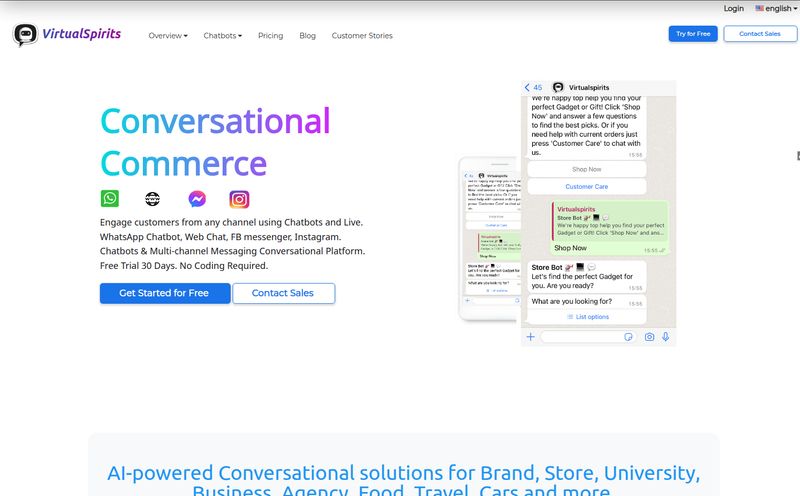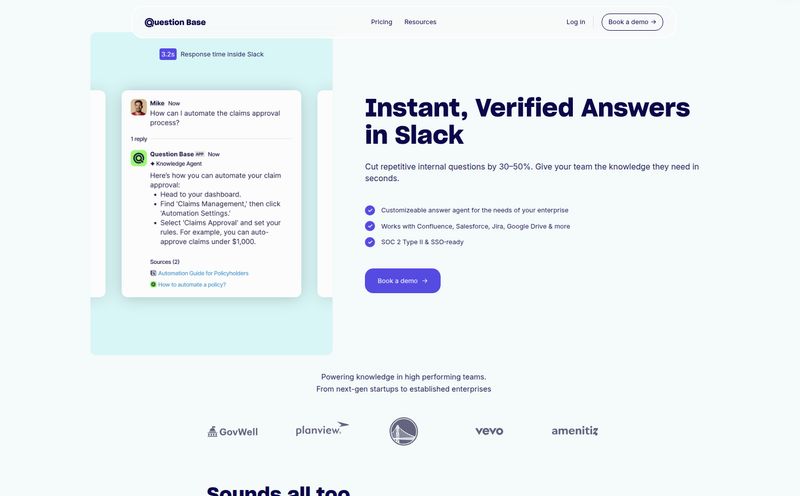So, the other day I was doing a bit of competitive research, you know how it is. Scrolling through product sites, seeing what's new in the SaaS world. I stumbled upon a tool called ProductlyAI. The name itself was intriguing—another player in the AI-for-product-managers space. My interest was piqued. I typed it into my search bar, clicked the first promising link, and landed on… an Indonesian online gambling blog.
I kid you not. The URL had the right name, but the content was all about 'Slot Online' and 'Strategi Menang' (Winning Strategies). For a second, I thought, “Wow, SaaS monetization has gotten really weird.” It was a perfect, if slightly absurd, reminder of the wild west that the internet can still be. A domain name is one thing, the content is another entirely.
Anyway, after a bit more digging, I found the real ProductlyAI. And let me tell you, it's a whole lot more interesting than online slots, especially if you’ve ever been responsible for a product roadmap. It’s a tool designed to solve a problem that gives PMs and support leads a special kind of recurring nightmare.
What is ProductlyAI, Really?
Let’s cut through the marketing jargon. At its core, ProductlyAI is an automated listening post. You know all those customer conversations happening in a million different places? The feature requests dropped in a random Slack channel? The bug reports in an Intercom chat? The subtle hints of frustration in a support ticket?
ProductlyAI swoops in, reads through all of it using AI, and automatically logs anything that smells like product feedback. Think of it as a super-diligent, hyper-focused intern who never sleeps, never complains, and whose only job is to create a tidy, organized list of every single feature request, improvement idea, and user complaint. It then pipes this organized feedback into a central location and can even ping you on Slack when something important pops up.
It’s designed to stop valuable insights from vanishing into the digital ether. And lord knows, we’ve all lost a few of those.
The All-Too-Familiar Pain of Manual Feedback Tracking
If you've ever managed a product, you know the drill. It’s a mess. A total, unadulterated mess. You have a Google Sheet here, a Trello board there, a Slack channel called #feedback that’s 90% memes, and a folder of screenshots on your desktop labeled “user_ideas_final_v2_final_FINAL.”
The “process,” if you can call it that, involves a heroic effort of copy-pasting, collating, and trying to spot trends with the naked eye. It’s not just inefficient; it’s fundamentally flawed. It leads to what I call “loudest voice syndrome,” where the one customer who complains the most (or the exec who had a random shower thought) gets their feature built, while the quiet, persistent hum of a dozen customers asking for a small but critical tweak gets ignored.
I’ve been there. I once spent the better part of a week building a report from Intercom tags only to have my boss ask, “But what about the feedback from the sales team’s Slack channel?” It’s a soul-crushing, time-sucking task that takes you away from the work that actually matters: talking to users and building a better product.

Visit ProductlyAI
How ProductlyAI Aims to Fix the Chaos
This is where a tool like ProductlyAI wades into the fray. It doesn’t just offer a single bucket to put things in; it tries to automate the entire process of filling that bucket.
The AI That Does the Reading For You
The main hook is the AI. It scans conversations in your connected platforms (like Intercom) and uses natural language processing to identify what’s a feature request, what’s a bug report, and what’s just general chatter. It then categorizes it automatically. Now, let’s be real. Is the AI perfect? Probably not. I've yet to see an AI that can perfectly interpret human sarcasm or the nuance of a frustrated-but-trying-to-be-polite customer. But it doesn't have to be perfect. It just has to be better than one overworked PM trying to read 500 conversations a day. It’s a hug step up from manual tagging, that’s for sure.
Connecting Your Tools, Connecting Your Teams
This, for me, is the real magic. ProductlyAI integrates directly with platforms like Intercom and Slack. This is critical. The best tools are the ones that meet you where you already are. By plugging into the platforms where conversations are already happening, it removes the friction of having to teach your entire company a new workflow. The support team can keep using Intercom, the product team can keep an eye on things via Slack notifications. No new tabs to keep open. No new logins to forget.
A Central Hub for Customer Truth
By pulling everything into one place, you get a single source of truth. Suddenly, you can see that 15 different users have asked for a specific integration this month. You can spot a rising trend of complaints about a particular feature before it becomes a five-alarm fire. This centralized view is what allows you to move from making gut-feel decisions to data-informed decisions about your product roadmap. It transforms feedback from a collection of anecdotes into a powerful dataset.
The Good, The Bad, and The Setup
No tool is a silver bullet, and from what I can gather, ProductlyAI is no exception. Here’s my take on the highs and potential lows.
What I really like is the promise of automation. The time savings alone could be worth the price of admission. The integrations are spot on—they’ve targeted the right platforms where this kind of unstructured feedback lives. And the real-time Slack notifications for escalations or critical issues? That’s not just a feature; it's a potential lifesaver for customer retention.
However, let's look at the other side. You're placing a lot of trust in the AI's accuracy. If it starts missing key feedback or miscategorizing things, you could end up with a garbage-in, garbage-out situation. Then there's the risk of notification overload. It's ironic, but a tool designed to reduce noise could just create a different kind of noise if you don't fine-tune your Slack alerts. You could go from missing feedback in Intercom to ignoring it in a cluttered Slack channel. Lastly, like any powerful tool, there's likely some initial setup required to dial it in and teach it your specific needs.
So, What's the Price Tag?
This is the million-dollar question, isn't it? I scoured their site for a pricing page and came up empty. This isn't uncommon for B2B SaaS tools, especially newer ones. It usually means they're targeting mid-market or enterprise clients and want to get you on a demo call to tailor a quote. My guess is we're looking at a tiered subscription model based on the number of users, conversations analyzed, or integrations. For now, if you want to know the cost, you’ll have to reach out to them directly.
Is ProductlyAI Right for You?
Who stands to gain the most from this? I see a few key profiles:
- Product Managers: This is the obvious one. If you’re the person responsible for the roadmap, this tool is built for you. It’s your trend-spotter and prioritization assistant.
- Customer Support & Success Leads: You’re on the front lines. This helps ensure the valuable insights your team gathers don't just get logged and forgotten. It closes the loop between support and product.
- Startup Founders: In the early days, you're everyone. You’re the PM, the support team, and the CEO. A tool like this can give you back precious hours and keep you dialed into your first users' needs.
If you're a small team still managing feedback effectively in a single spreadsheet, you might not feel the pain yet. But if you've ever declared “feedback bankruptcy” and just given up on organizing it, then you're exactly who ProductlyAI is trying to help.
Frequently Asked Questions
How does the AI actually know what is feedback?
It uses Natural Language Processing (NLP), a type of AI that's trained to understand the intent and sentiment behind human language. It looks for keywords (like 'bug', 'request', 'wish'), sentence structure, and other cues to distinguish a feature request from a simple question.
What if the AI gets it wrong?
While not explicitly stated, most AI systems like this include a mechanism for human review and correction. This helps the model learn and improve over time. You'd likely be able to manually re-categorize any feedback the AI misinterprets.
Is it difficult to set up?
The initial setup probably involves authorizing access to your Slack and Intercom accounts, which is usually a simple click-and-approve process. The more involved part would be configuring your notification settings and perhaps fine-tuning the AI's categorization to match your team's terminology.
How is this different from just using tags in Intercom?
Tags are manual. They rely on every single support agent remembering to apply the correct tag, consistently, to every relevant conversation. ProductlyAI aims to automate that first pass, catching things agents might miss and providing a more consistent, overarching view without the manual labor.
Does it integrate with other tools besides Slack and Intercom?
The core marketing materials focus heavily on Slack and Intercom. The site mentions 'and more,' which suggests they may have other integrations available or on their roadmap. You would need to check with their team for a current list.
What about data privacy and security?
This is a crucial question for any tool that accesses customer conversations. A reputable provider will have clear policies on data handling, encryption, and compliance with regulations like GDPR. This would be a top question to ask during a demo.
Final Thoughts on a Crowded Field
The world of product management tools is getting crowded. But ProductlyAI is targeting a very real, very specific pain point. The move from chaotic, manual feedback collection to an automated, centralized system is a massive quality-of-life improvement for any product team.
While I started my investigation with a comical detour into the world of online gambling, the actual ProductlyAI is a serious tool for a serious problem. If you're drowning in user feedback and your spreadsheets are starting to weep, it’s probably worth a look. It could be the thing that finally helps you hear the signal through all the noise.
Reference and Sources
- ProductlyAI Official Website
- Intercom's Guide to Building a Product Feedback Loop
- Mind the Product: What to do with all the user feedback



